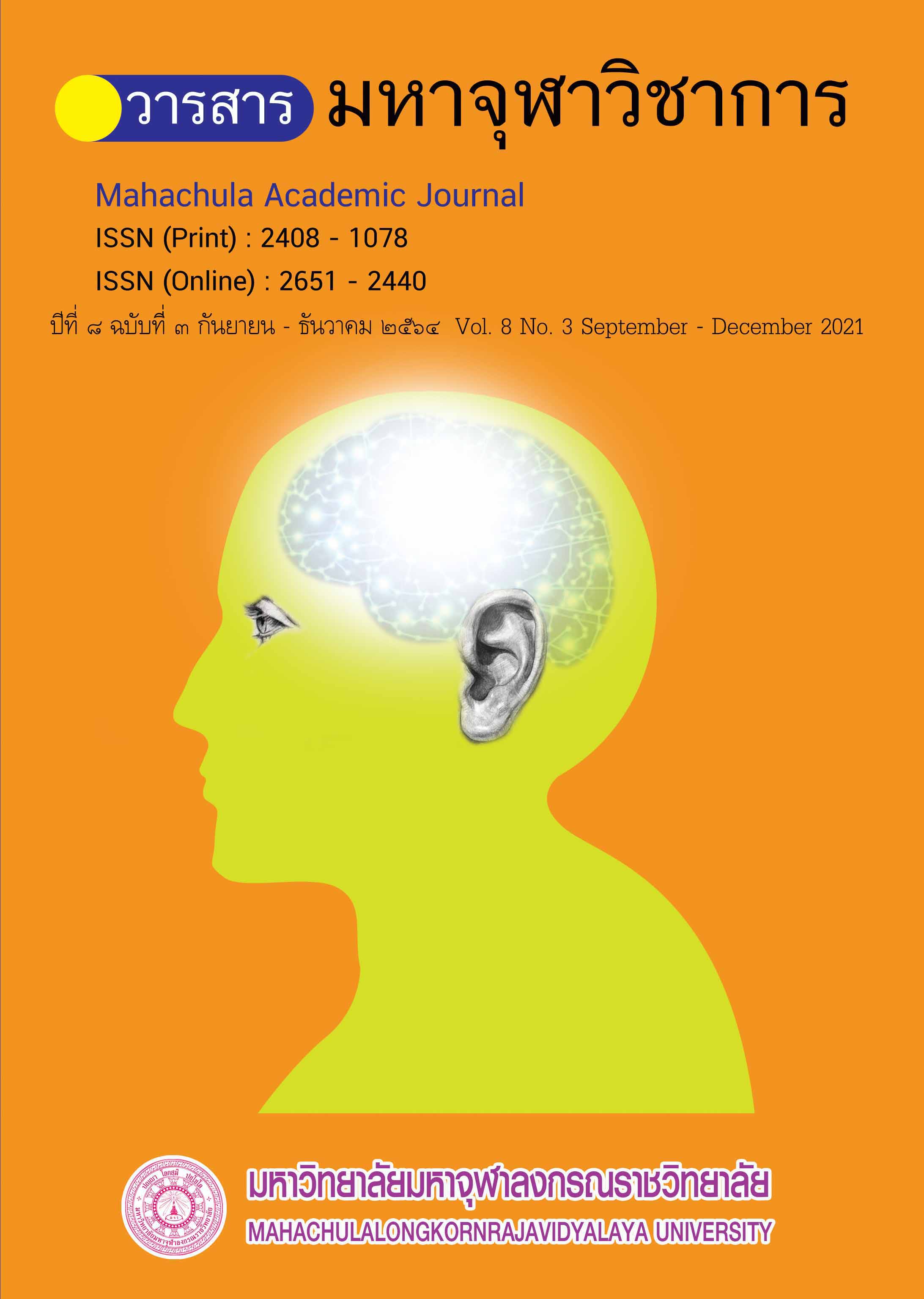Buddhism and the food as necessary Factors for the Livelihood to develop the mind
Main Article Content
Abstract
This academic article title on The Buddhism and the food as necessary factors for the livelihood to develop the mind aims to study food problems as important factors for life, the livelihood of farmers for food production, the way for planning, prevention, correction, and mental development according to Buddhist principles.
By studying and analyzing food problems in the way of life in Thai society for analysis, management, improvement, and development toward the objectives without conflicting the lifestyle of both people and animals. Buddhism has always viewed food and the coexistence of all living beings in a positive way from the time of the Buddha until the present. Especially the current situation is the spread of a new breed of coronavirus 2019 (COVID 19) causing a food crisis. Buddhism has an important concept and role as a medium for the society to know how to solve problems that arise. By the monks who are modest in meditating no more no less with consideration know the value of food. It also helps encourage society to rely on each other and to develop the mind.
Article Details
References
กองบรรณาธิการ. “คู่คิดชาวนาข้าวต้านเพลี้ยกระโดดสีน้ำตาล”. น.ส.พ.กสิกร ปีที่ ๘๓ ฉบับที่ ๓ (พฤษภาคม-มิถุนายน ๒๕๕๓) : ๑๙-๒๔.
คณะกรรมการพัฒนาการเศรษฐกิจและสังคมแห่งชาติ. แผนพัฒนาเศรษฐกิจและสังคมแห่งชาติ. ฉบับที่ ๑๑ ๒๕๕๕-๕๕๕๙. กรุงเทพมหานคร : สำนักงาน. สำนักนายกรัฐมนตรี. ๒๕๕๕.
คณะกรรมการอาหารแห่งชาติ. กรอบยุทธศาสตร์การจัดการด้านอาหารของประเทศไทย. กรุงเทพมหานคร : สำนักงานกองทุนสนับสนุนการสร้างเสริมสุขภาพ (สสส.). ๒๕๕๕.
พระพรหมคุณาภรณ์ (ป. อ. ปยุตโต). โยนิโสมนสิการ-วิธีคิดตามหลักพุทธธรรม. กรุงเทพมหานคร : สานักพิมพ์ปัญญาประดิษฐาน ๒๕๕๖.
มหาจุฬาลงกรณราชวิทยาลัย. พระไตรปิฎกภาษาบาลี ฉบับมหาจุฬาเตปิฎก ๒๕๐๐. กรุงเทพนคร : มหาจุฬาลงกรณราชวิทยาลัย. ๒๕๓๕.
มหาจุฬาลงกรณราชวิทยาลัย. พระไตรปิฎกฉบับภาษาไทย. ฉบับมหาจุฬาลงกรณราชวิทยาลัย. กรุงเทพมหานคร : มหาจุฬาลงกรณราชวิทยาลัย. ๒๕๓๙.
วรภักธ์ ภควงศ์. "ใกล้สูญพันธุ์เกษตรกรไทยเรื่องที่น่าห่วงใยใกล้ตัว". วารสารเศรษฐกิจการเกษตร. ปีที่ ๕๙ ฉบับที่ ๖๘๐ (กรกฎาคม ๒๕๕๖).
สำนักสุขาภิบาลอาหารและยา. คู่มือวิชาการสุขาภิบาลอาหารสำหรับเจ้าหน้าที่. กรมอนามัย กระทรวงสาธารณสุข. ๒๕๕๖.
สุวรรณี คำมั่น. ความมั่นคงด้านอาหารระดับนานาชาติและระดับประเทศ. เอกสาร/ภาพประกอบการบรรยาย การประชุมวิชาการโภชนาการแห่งชาติ ครั้งที่ ๕. ณ ศูนย์แสดงนิทรรศการ และการประชุมไบเทคบางนา กรุงเทพมหานคร (๕ กันยายน ๒๕๕๔).
สำนักงานปลัดกระทรวงทรัพยากรธรรมชาติและสิ่งแวดล้อม. ความรู้เบื้องต้นเกี่ยวกับการพัฒนาที่ยั่งยืน. กระทรวงทรัพยากรธรรมชาติและสิ่งแวดล้อม. อมรินทร์พริ้นติ้งแอนด์พับลิชชิ่ง จำกัด. ๒๕๕๖.
กชพรรณ วงศ์เจริญ และคณะ. “การอนุรักษ์และฟื้นฟูแหล่งอาหารเพื่อสร้างความมั่นคงทางอาหาร บนพื้นฐานทุนทางทรัพยากรธรรมชาติ”. วารสารมนุษยศาสตร์และสังคมศาสตร์ มหาวิทยาลัยมหาสารคาม การประชุมวิชาการมหาวิทยาลัยมหาสารคามวิจัย ครั้งที่ ๙. [ออนไลน์]. แหล่งที่มา: http://www.journal.msu.ac.th/index.php?page=show. [๒๘ มกราคม ๖๐].
มูลนิธิเกษตรกรรมยั่งยืน. ชุมชนปลูกอาหารปลูกประเทศ. [ออนไลน์]. แหล่งที่มา: www.sathai.org/th/news/hot-sue/item/ 463/html. [๑๕ กุมภาพันธ์ ๒๕๕๖].
Michiel van Dijk, et al. A meta-analysis of projected global food demand and population at risk of hunger for the period 2010–2050. [ออนไลน์]. แหล่งที่มา: https://www.nature.com/articles/s43016-021-00322-9.pdf [๒๓ พฤศจิกายน ๒๕๖๔].
Arden Henley. How to Sustainably Feed 10 Billion People by 2050, in 21 Charts. [ออนไลน์]. แหล่งที่มา: https://www.gteccanada.ca/how-to-sustainably-feed-10-billion-people-by-2050-in-21-charts/. [๒๖ พฤศจิกายน ๒๕๖๔].


